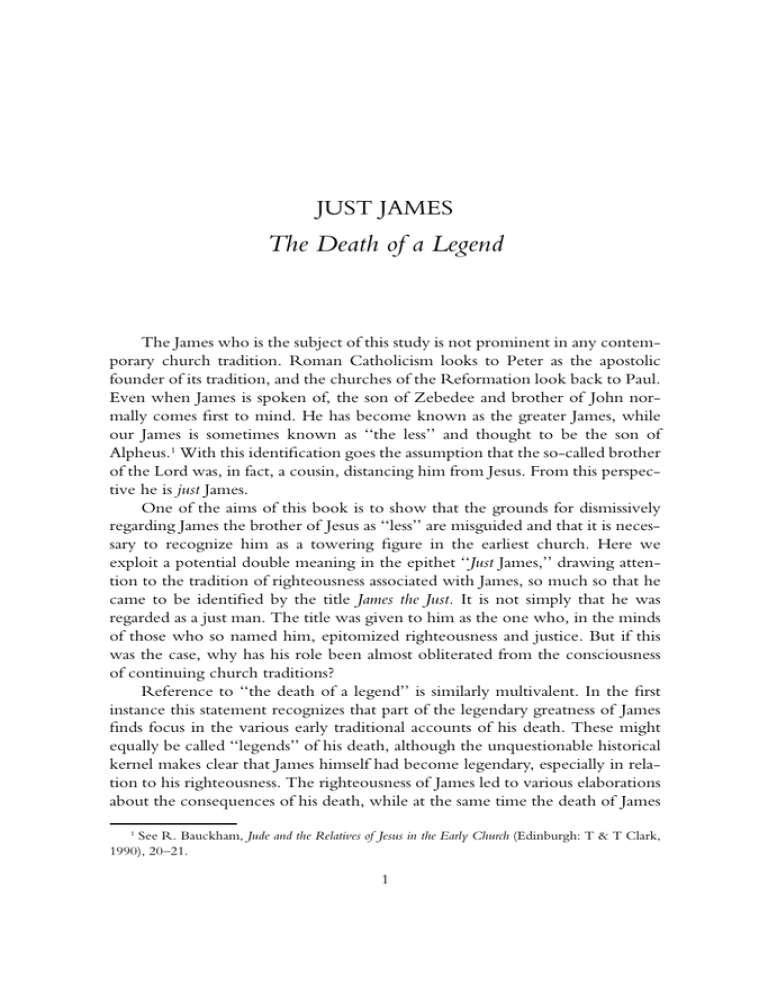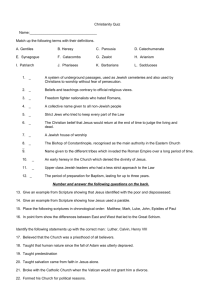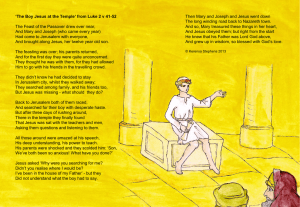The Death of a Legend JUST JAMES
advertisement

JUST JAMES The Death of a Legend The James who is the subject of this study is not prominent in any contemporary church tradition. Roman Catholicism looks to Peter as the apostolic founder of its tradition, and the churches of the Reformation look back to Paul. Even when James is spoken of, the son of Zebedee and brother of John normally comes first to mind. He has become known as the greater James, while our James is sometimes known as ‘‘the less’’ and thought to be the son of Alpheus.1 With this identification goes the assumption that the so-called brother of the Lord was, in fact, a cousin, distancing him from Jesus. From this perspective he is just James. One of the aims of this book is to show that the grounds for dismissively regarding James the brother of Jesus as ‘‘less’’ are misguided and that it is necessary to recognize him as a towering figure in the earliest church. Here we exploit a potential double meaning in the epithet ‘‘Just James,’’ drawing attention to the tradition of righteousness associated with James, so much so that he came to be identified by the title James the Just. It is not simply that he was regarded as a just man. The title was given to him as the one who, in the minds of those who so named him, epitomized righteousness and justice. But if this was the case, why has his role been almost obliterated from the consciousness of continuing church traditions? Reference to ‘‘the death of a legend’’ is similarly multivalent. In the first instance this statement recognizes that part of the legendary greatness of James finds focus in the various early traditional accounts of his death. These might equally be called ‘‘legends’’ of his death, although the unquestionable historical kernel makes clear that James himself had become legendary, especially in relation to his righteousness. The righteousness of James led to various elaborations about the consequences of his death, while at the same time the death of James 1 See R. Bauckham, Jude and the Relatives of Jesus in the Early Church (Edinburgh: T & T Clark, 1990), 20–21. 1 2 Just James: The Death of a Legend contributed to the appreciation of his righteousness in legendary terms. The focus on the death of James in the tradition justifies the caption ‘‘The Death of a Legend.’’ The developing tradition found expression in the legend of the perpetual virginity of Mary, the mother of Jesus, which was made possible by teaching found in such infancy Gospels as the Protevangelium of James. There, in narrative form, it was taught that Joseph was a widower with children (including James) when he became betrothed to Mary. Mary was a virgin when she conceived Jesus, and she remained a virgin through the process of birth and throughout her life. With the influence of Jerome, whose views were adopted and spread by Augustine, this legend was suppressed in the West and another legend put in its place. According to Jerome, those referred to as brothers and sisters were actually Jesus’ cousins. Jerome sought to preserve the virginity of both Joseph and Mary. The death of one legend saw the birth of another. Modern study, beginning with the work of J. B. Lightfoot, has shown that the theory advocated by Jerome entails insuperable problems. Modern Western scholarship has tended to regard this approach to the ‘‘brothers’’ of Jesus as indefensible legend. Lightfoot, however, began a process of reexamining the viability of the older tradition in the Protevangelium of James. From the point of view of the present study, Lightfoot announced the death of one legend only to replace it with another. Although Lightfoot’s position has been supported by other, more modern studies,2 most modern research on the subject seeks to show that both legends are dead. The name James is derived from the Semitic Jacob,3 a name that recalls the third of the great patriarchs of the Jewish people. It was a common Jewish name in the first century. In the New Testament the name is used over sixty times of as many as eight persons: 1) the patriarch Jacob; 2) the father of Joseph, the supposed father of Jesus; 3) the son of Zebedee and the brother of John, one of the twelve; 4) the son of Alpheus, one of the twelve; 5) James the ‘‘less,’’ son of Mary and Clopas and brother of Joses ( Joseph); 6) the father (brother?) of Judas, one of the twelve, who may be identified with Thaddaeus (Lebbaeus); 7) James the brother of Jude and author of the Epistle of James; 8) James, the brother of the Lord and leader of the Jerusalem church. It is possible to reduce this number by arguing that some of these uses are to be identified with the same person. Jacob (’Iακβ) is used twenty-four times of the patriarch Jacob and twice of the father of Joseph the supposed father of Jesus (Matt 1:15, 16).4 Other references in the New Testament use the hellenized form (’Iκωβος) which is consistently transSee, e.g., Bauckham, Jude. ’Iακβ, which is hellenized as ’Iκωβος. 4 In Luke (3:23) the father of Joseph is named Eli. 2 3 Just James: The Death of a Legend 3 lated as James. About half the uses are to be identified with James the brother of John and son of Zebedee, while almost a third probably refer to the James known as the brother of Jesus. The remaining references relate to figures often difficult to identify, though some refer to the other apostle named James. The differentiated use of the two forms of the name in the New Testament, where figures in ‘‘Christian’’ history are given the hellenized form while those from Jewish history prior to Jesus, especially the patriarch Jacob, retain the Semitic form, may have led the English translators of the Bible to retain Jacob as an Old Testament name, while using James as the name for the Christian apostles. The two names in English are derived from Latin, in which Jacobus and Jacomus are variants of the same name. The same variants exist in some European languages: for example, in Italian Jacapo and Giacomo, in Spanish Iago and Jaime. But in English Jacob and James have tended to be regarded as two different names. The one name ( Jacob), apart from times when there has been an attraction to the use of Old Testament names, has tended to be used by Jews, while the other ( James) has been used by Christians. Reference to the supporters of the Stuart Jameses as Jacobites and to their period as Jacobean shows awareness of the etymological relation of the two names. In the Christian tradition the name James is sometimes used without clarification. This contributes to the confusion and difficulty of identifying our subject within the documents of the New Testament. Such confusion is rare in the other early Christian literature. One reason for this is that the martyrdom of James, brother of John and son of Zebedee, is narrated in Acts 12:1–2. He was executed by King Herod (Agrippa I), who was king of ‘‘Palestine’’5 from 42–44 . This time frame leaves little room for notable activity by this James, and early legendary development is restricted to elaborating the tradition concerning his death. Eusebius (HE 2.9.2–3) records a report from Clement of Alexandria (ca. 200 ) saying that James forgave his accuser, and the apocryphal Apostolic History of Abdias describes the miracles and controversies leading up to his execution. This James was, according to the Synoptics, a notable figure among Jesus’ disciples, being (according to the Synoptics) one of the first four called by Jesus and one who remained part of a significant nucleus reduced at times to the three, Peter, James, and John. In early church tradition, however, James the brother of Jesus held central stage for some time. He was the fountainhead of traditions used to further the interests and causes of a variety of groups, including Jewish Christian, the Great Church (Catholic), and Gnostic. By the end of the patristic period, this fountain had run dry. In the traditions recorded by Eusebius (Hegesippus, Clement of Alexan5 While this name is an anachronism, it conveniently signifies collectively what were separate political regions in the first century. 4 Just James: The Death of a Legend dria, Origen), James was the first bishop of the Jerusalem church. His election to this position is located at the beginning of the life of the Jerusalem church. He was thus the first bishop of the leading (mother) church of the growing Christian movement. The account in Acts portrays the key role of the Jerusalem church, and even the letters of Paul confirm its importance because they show that Paul contested and struggled against that leadership. But according to popular understanding, in Acts Peter is at first portrayed as the prominent leader among the twelve, giving way to James only when he is forced to leave Jerusalem (Acts 12:17). The account of the Jerusalem assembly (Acts 15) portrays James ‘‘presiding,’’ and this position of leadership is consistent with the remainder of the narrative of Acts. The tendentious nature of Acts is widely recognized, and this is crucial for the study of James. But that this is also true of the letters of Paul is not always remembered because awareness that his letters provide firsthand knowledge of people and events often seduces scholars to forget that primary sources also need critical evaluation. These comments apply particularly to the discussion of the relation between Paul and James. In spite of the suppression of the importance of the family of Jesus in the New Testament texts there is ample evidence of its presence. Matthew and Luke reduce the cohesion of the family by affirming that Jesus was conceived by Mary while she was a virgin, so that other children born to the family did not share a biological father with Jesus. Although the point of the infancy stories in Matthew and Luke was to affirm the significance of Jesus, they had the effect of minimizing the importance of the family, apart from Mary. In following centuries the continuing virginity of Mary became important as a way of affirming the uniqueness of Jesus and of developing a focus on Mary herself as an idealization of the feminine and of virginity. As we noted above, the Protevangelium of James preserved the virginity of Mary perpetually. Jerome went further and maintained the virginity of Joseph also by arguing that those called brothers (and sisters) were actually cousins. These views become known by the names of leading exponents in the fourth century. The first was advocated by Epiphanius and remained the dominant view of the Eastern Church, while Jerome’s view became dominant in the West. Until recently Jerome’s was the Roman Catholic view, though Catholic biblical scholars do not uniformly hold this view today. A mural in the crypt of the Benedictine Dormition Abbey in Jerusalem depicts a scene which portrays the Epiphanian view. Portrayed in a scene of the flight into Egypt, the youthful James is seen leading the donkey upon which sits Mary with the infant Jesus. The writings of the New Testament represent different interest groups. None of those groups represents the interests of James. In the early church traditions representing both Peter and Paul obscured the importance of James and the family of Jesus. In spite of this, in traditions from the second century Just James: The Death of a Legend 5 on, there re-emerges awareness of James as the leading figure in the Jerusalem church. According to Hippolytus (Ref. 5.2) James was venerated by the Naassenes as the figure by whom the secret teachings were transmitted to the sect via Mariamne. Thus there is evidence of an early ( Jewish) Gnostic appeal to the traditions of James. Hegesippus provides evidence of the reclamation of James by the Great Church. But that reclamation is unintelligible unless there was an awareness of the tradition that established the importance of James in the life of the church. James was too important to surrender to the Gnostics. Tradition names James the first leader of the Jerusalem church. The list of the bishops of Jerusalem, the first fourteen Jewish (Hebrew) and the next fourteen Gentile, cites James as the first of the Hebrew bishops.6 Various traditions affirm his appointment, directly by the risen Jesus,7 by Peter, James, and John,8 or by the apostles as a group.9 These variations make best sense if the earliest tradition affirmed that the risen Jesus directly appointed him. In the variant traditions James is brought back under the control of the Great Church by attributing his appointment to the apostles. James is also made the recipient of special revelations from the risen Lord.10 Because this tradition exposed James to the whims of the Gnostics, James is sometimes linked with Peter.11 Underlying the choice of James as the first leader and his position as the repository of the secret tradition is his acknowledged position as the ‘‘brother’’ of Jesus. Even Eusebius, who qualifies his understanding of that tradition, acknowledges that James was known as the brother of Jesus and attributes tradition to this effect to Hegesippus. Tradition of the martyrdom of James is known to us in Josephus (Ant. 20.197–203) and Christian traditions gathered by Eusebius from a variety of sources of which Clement of Alexandria and Hegesippus are named. James, in addition to being called the Lord’s brother, is referred to as ‘‘the Just’’ or ‘‘the Righteous.’’ Use of this epithet manifests the status of James in the role of the righteous sufferer. He is at once perceived in this role in the company of Jesus (Luke 23:47) and of other Jewish righteous martyrs. Once in this company, the epithet ‘‘Righteous’’ takes on a sense of piety and asceticism for which James became famous, so that Mary-ever-virgin is joined by the virgin James. 6 See the tradition reported by Eusebius, HE 4.5.1–4. Epiphanius, Ref. (Pan.) 66.19.7–66.20.1, mentions thirty-seven bishops. 7 See Kerygmata Petrou, Ascents of James, and the Gospel of Thomas logion 12. Perhaps implied by Clement of Alexandria as reported by Eusebius HE 2.1.4, where James is named first, followed by John and Peter, in the group of three to whom the risen Lord gave higher knowledge after the resurrection. 8 Clement of Alexandria according to Eusebius in HE 2.1.3. 9 HE 2.23.1. 10 Clement of Alexandria in HE 2.1.4; the Apocryphon of James; the First and the Second Apocalypse of James. 11 Clement of Alexandria in HE 2.1.4; the Apocryphon of James. 6 Just James: The Death of a Legend Eusebius acknowledges no Petrine leadership of the Jerusalem church. He does refer to Peter as the leader of all the apostles in the context of asserting that Peter brought the treasures of the gospel from the east to Rome in the reign of Claudius (HE 2.14.6). The authority of Peter is identified with Rome in a time too early (the reign of Claudius) and in a tradition too late (Eusebius) to be historically credible. But there is no suggestion that Peter was the leader of the Jerusalem church. Eusebius quotes Clement of Alexandria (HE 2.1.3) as saying that, after the ascension, Peter, James, and John chose James as the first bishop of Jerusalem.12 In his own interpretation Eusebius equates the time of James’s appointment with the martyrdom of Stephen (HE 2.1.2). While this shows that Eusebius has no detailed information, it is clear that he knows no tradition of Petrine leadership of the Jerusalem church. Like the tradition he quotes, he was concerned to show that the authority and leadership of James were rooted in the authority of the apostles. The Petrine tradition of leadership was associated with Rome (not Jerusalem). For Eusebius there was nothing superior about the authority of either Jerusalem or Rome. What was important was the tradition of apostolic churches, which were a bulwark against the aberrations of heresy. One of the aims of this book is to show the central role of James in the life of the earliest church. If it is true that he had this role, we also need to show what obscured the significance of his role in the ongoing mainstream traditions. James is central in certain traditions, but at some point these traditions ceased to be influential. What attracted the shapers of these traditions to James, and why did these traditions not continue to be influential? Attempting to provide some answers to these questions we gain a clearer perception of the life and struggles of the early church. We are forced to penetrate beneath the answers that were provided by the post-Constantinian Church, which read its kind of orthodoxy back into the earlier period. Perception of the significant role of James is only possible if we break through this construct. Modern studies of James have concentrated on a relatively limited number of questions. Naturally, the old question of the relationship of James to Jesus and Mary continues to be important and with this the question of which references to James, in the New Testament, are to this James. Was he the author of the letter that we know by that name? While the early church assumed that he was, this conclusion is widely questioned today. Since the time of F. C. Baur, who developed the hypothesis of a conflict between Jewish Christianity and Gentile Christianity, leading to a synthesis in Catholic Christianity, the question of the relationship of James to Paul has been crucial. Baur’s position, developed from 1831, is seminal for our discussion.13 He See also logion 12 of the Gospel of Thomas. ‘‘Die Christuspartei in der korinthischen Gemeinde, der Gegensatz des petrinischen und paulinischen Christentums in der alten Kirsche, der Apostel Petrus in Rom,’’ TZTh (1831): 61– 206. 12 13 Just James: The Death of a Legend 7 argued that the four apparent parties at Corinth were in fact two; that the party of Paul and Apollos stood over against the party of Cephas, i.e., Peter, and Christ.14 The latter represented Jewish particularism against the universalism of a spiritual gospel.15 He identified the Jewish Christian opposition to Paul with ‘‘false apostles’’ who are not to be identified with the original apostles (Peter and James). At that time he traced a line of continuity between the false apostles as the common opponents of Paul in Galatians, Philippians, 1 and 2 Corinthians and the opposition to Paul in the second century evidenced in Justin, the Pseudo-Clementines, and Irenaeus. While tracing this line of continuity was an important contribution, it is now widely recognized that Baur was too hasty in assuming that the second-century evidence to which he appealed referred to a single common front. The major development in his view was a consequence of historical critical attention to the Pastoral Epistles (1835) and Acts in work culminating in his Paul (first published in 1845). Baur began to show that the account in Acts ought not to be treated as accurate history, concluding that Peter and James were the leaders of the anti-Pauline movement. Consequently, our discussion of the question has been expanded to take in the relationship of James and Paul to Peter. In his introductory essay to the study Antioch and Rome (1983), by Raymond E. Brown and J. P. Meier, Brown outlines a model of four types of Jewish Christianity, based on an analysis of different attitudes to the law. Brown acknowledges that the use of such a typology is heuristic and does not mean that historical reality was as clear and simple as the model might seem to imply. In historical reality people and groups often overlap the types. The value of the types is that they make clear a series of distinct options that were open on the question of the observance of the law. The typology assumes that each of the Jewish groups spawned Gentile converts who adopted their views of the law. The first group insisted on full observance of the law, including circumcision. The second did not demand circumcision. The third did not demand circumcision or that one follow the food and purity laws but insisted on keeping the ten commandments and continued to observe the Jewish festivals. The fourth saw no relevance at all in any of the Jewish rituals. Brown thinks that James and Peter belonged to the second group, but that, while James inclined to the position of the first group, Peter was closer to the position of the third. Paul fits into the third, and a more extreme position is represented by the Hellenists. The position of Wilhelm Pratscher is similar in some respects to that of Brown and Meier.16 Pratscher, however, takes the differences between James ‘‘Christuspartei,’’ pp. 77, 83–84, 114. ‘‘Christuspartei,’’ p. 107. 16 See Pratscher’s Der Herrenbruder Jacobus und die Jacobustradition (Göttingen: Vandenhoeck & Ruprecht, 1987). 14 15 8 Just James: The Death of a Legend and Peter further and sees some rivalry between Peter’s people and those who supported James, arguing that 1 Cor 15:7 is a ‘‘Rivalitätsformel’’ (contrast 1 Cor 15:5). Instead of seeing Peter wavering somewhere between James and Paul, Pratscher argues that there is no trace of evidence concerning the antiPaulinism of James, who should be seen rather as one who mediated between Paul and the Jewish Christians who opposed Paul.17 Thus Pratscher sees James playing a reconciling role. While these may appear to be small differences, they lead to a very different understanding of early Christianity and, of course, to the role of James within it. Historically, much depends on the way the accord negotiated at the Jerusalem assembly is reconstructed. It is frequently recognized that the account in Acts cannot be read as straightforward history. Paul’s firsthand account is not without its own Tendenz, or bias.18 The terminology used by Paul in Galatians is likely to favor his interpretation of the events, and the reader needs to be sensitive to alternative understandings that were open to other participants in the dialogue. This would include (minimally) different understandings of the language of the agreement and perhaps even completely alternative accounts of the accord. 17 This is the position of H. J. Schoeps, Theologie und Geschichte des Judenchristentums (Tübingen: J. C. B. Mohr [Paul Siebeck], 1949), 261, and R. B. Ward (‘‘James of Jerusalem in the First Two Centuries,’’ ANRW II, 26.1, p. 784), who builds on the work of J. Munck (Paul and the Salvation of Mankind [London: SCM, 1959], 107). 18 Since I wrote the first draft of this study M. D. Goulder’s A Tale of Two Missions (London: SCM, 1994) has appeared. Goulder notes the tendentious nature of Luke but appeals to the letters of Paul for evidence of what actually happened because, after all, ‘‘Paul was there at the time.’’ See A Tale of Two Missions, pp. x–xi.








